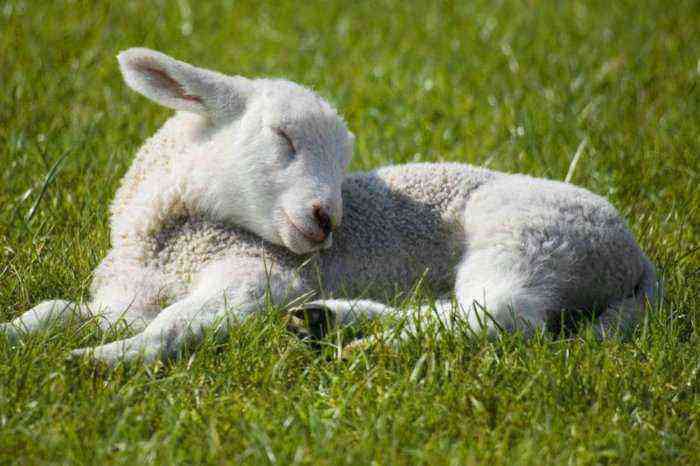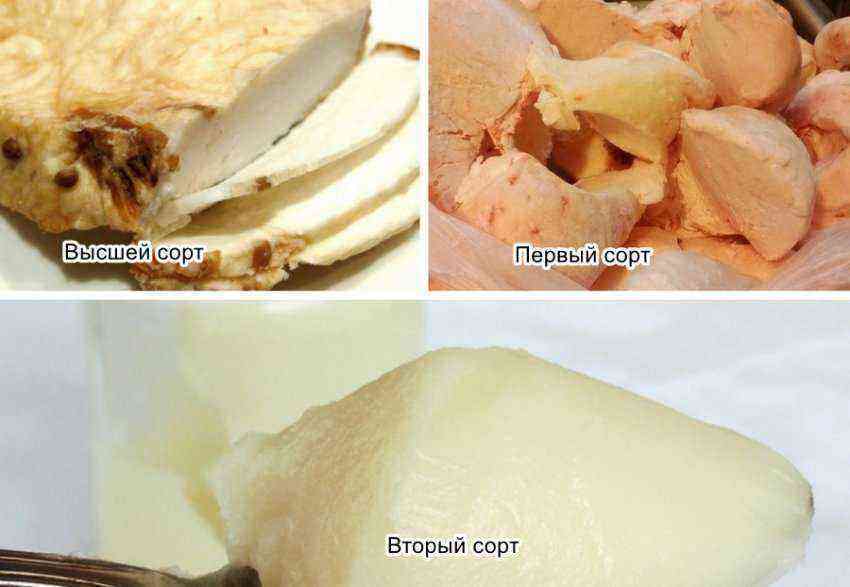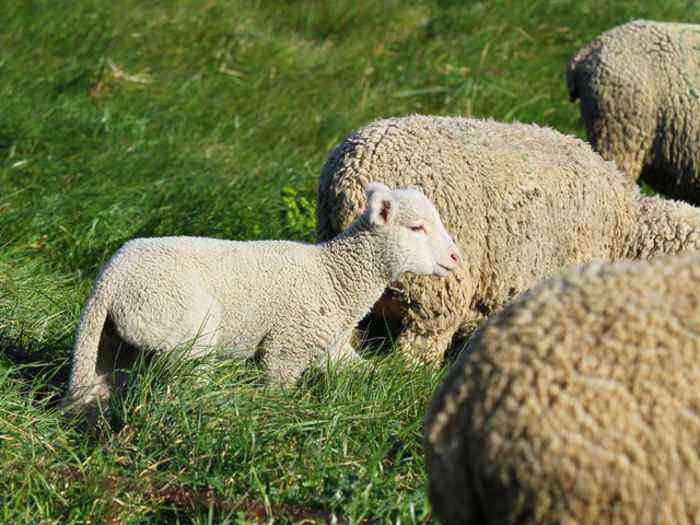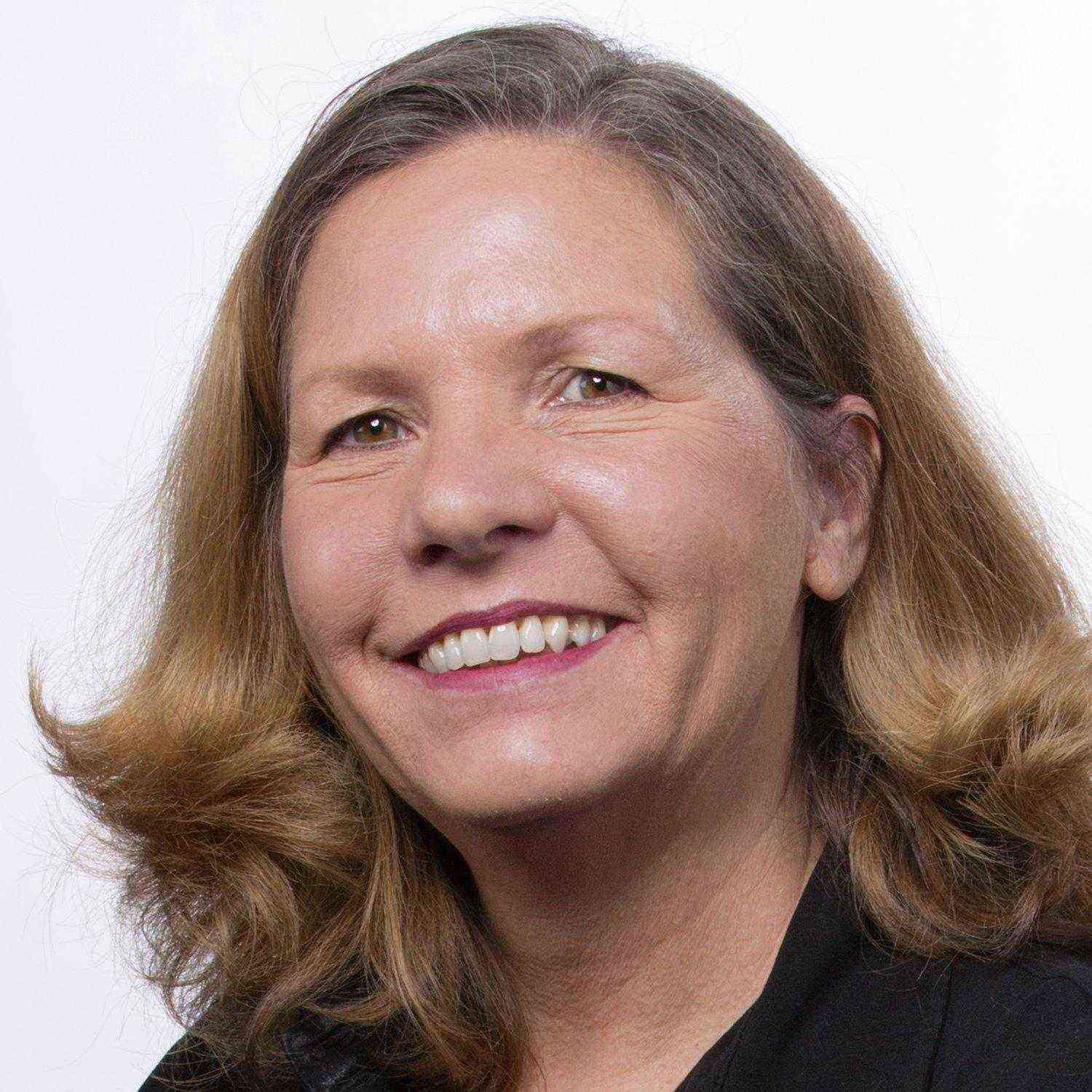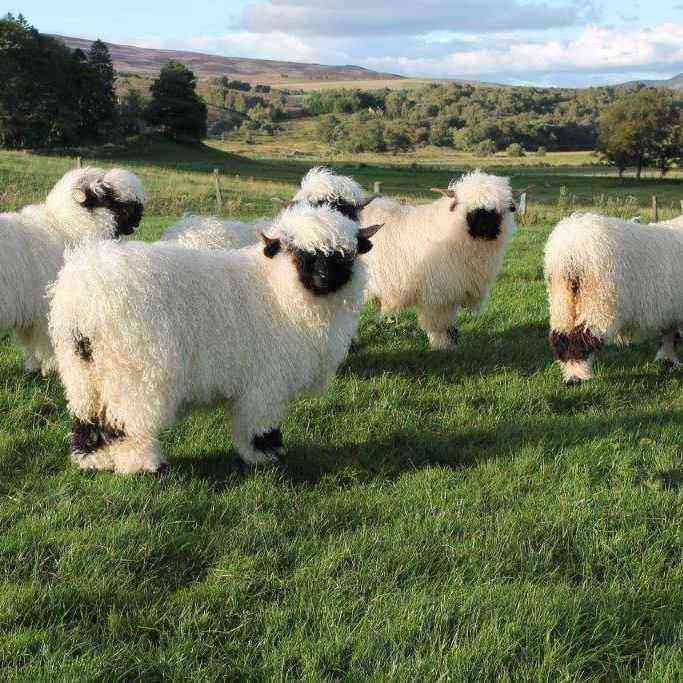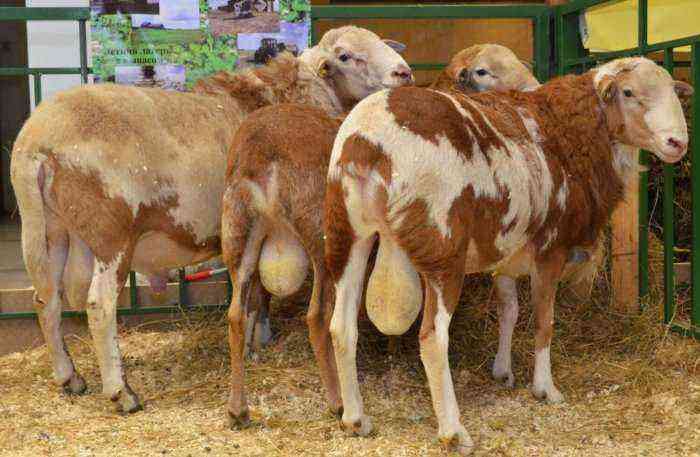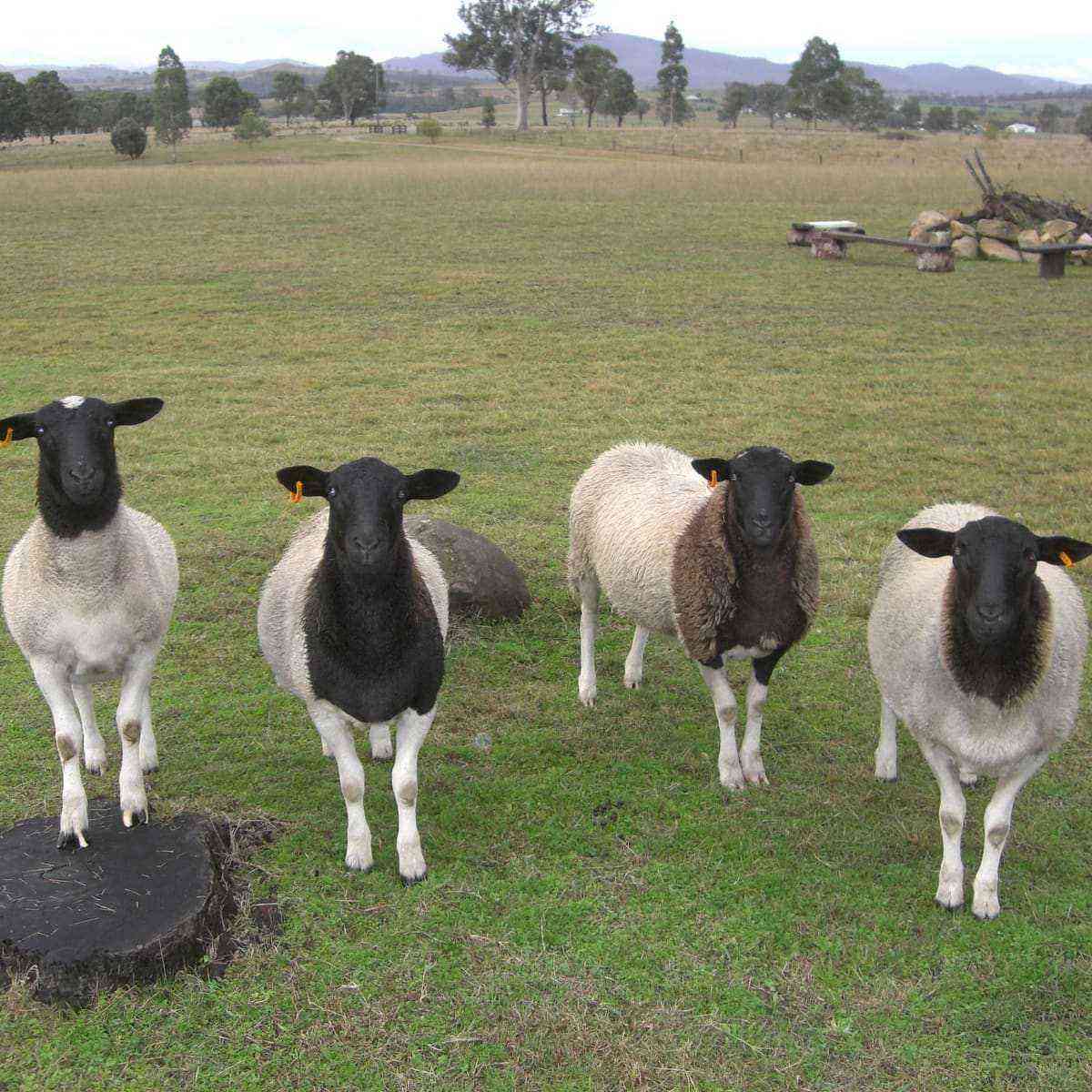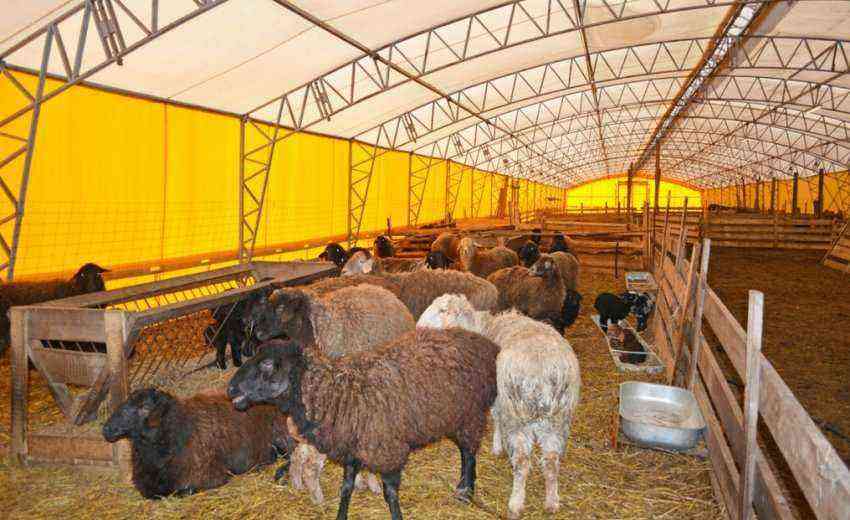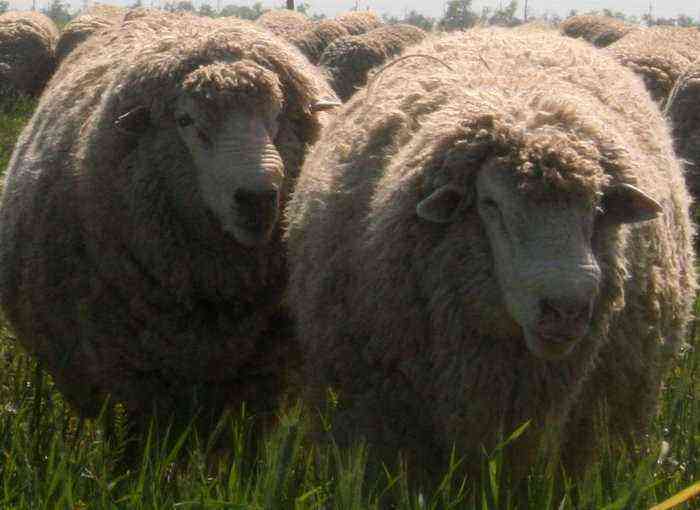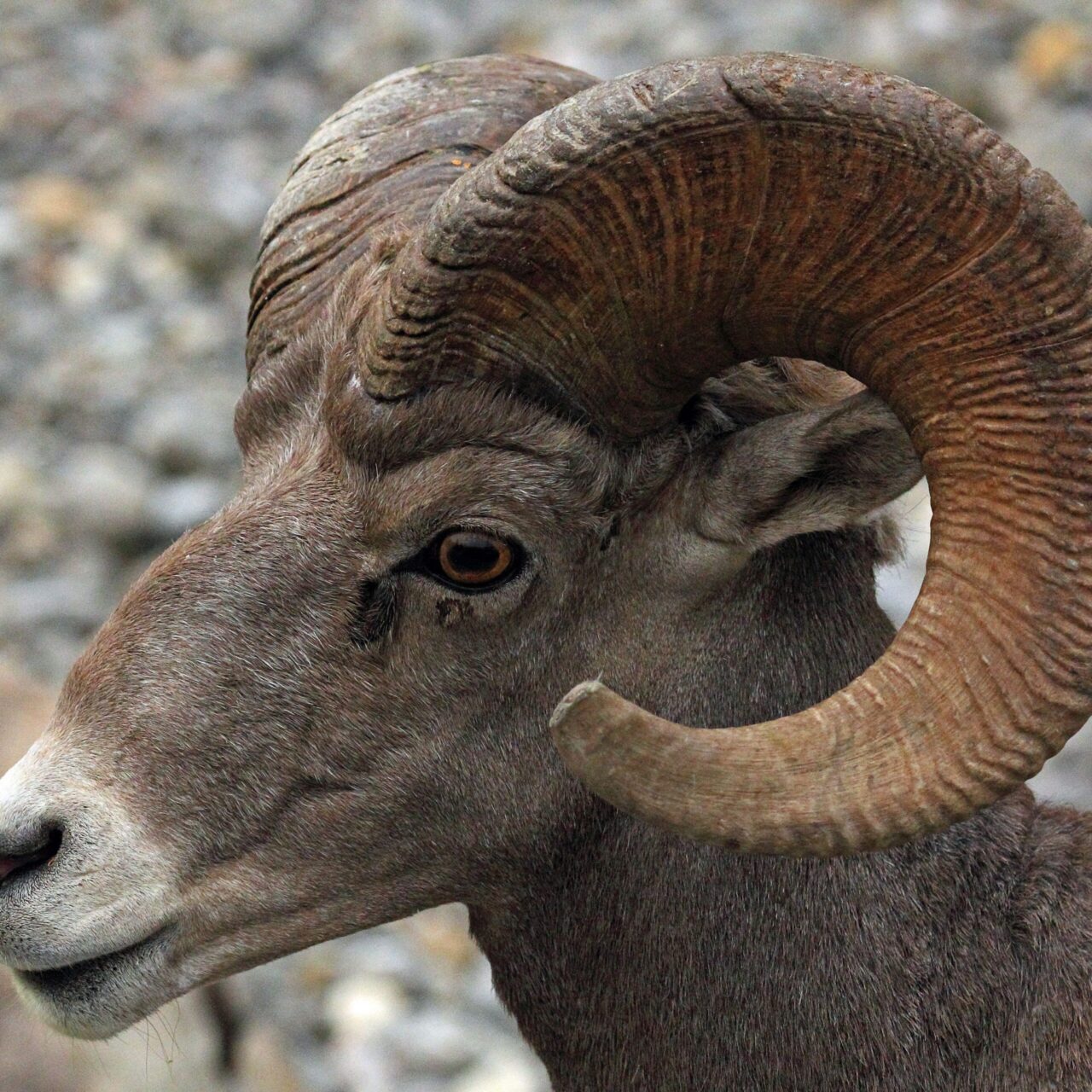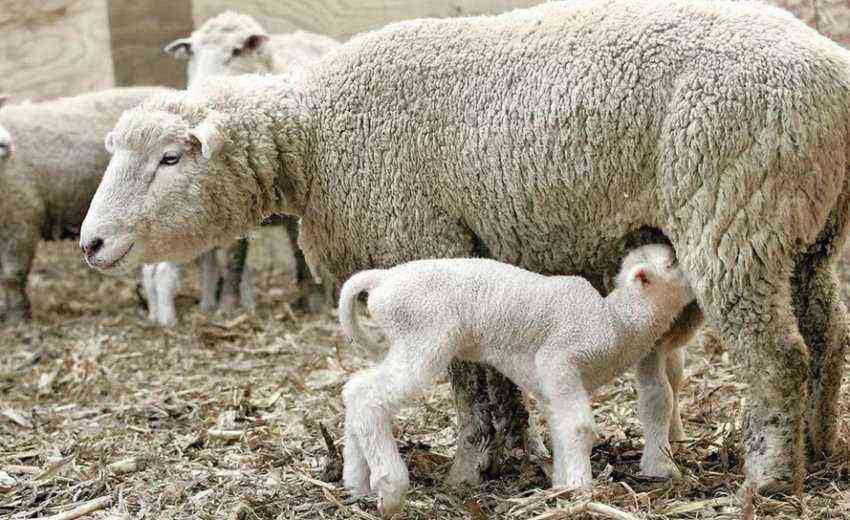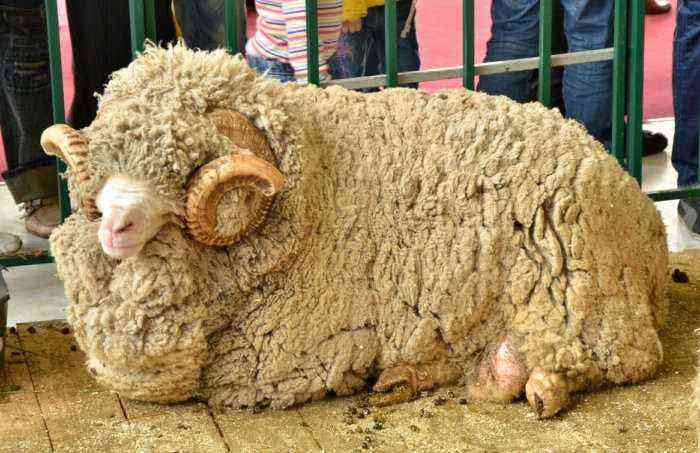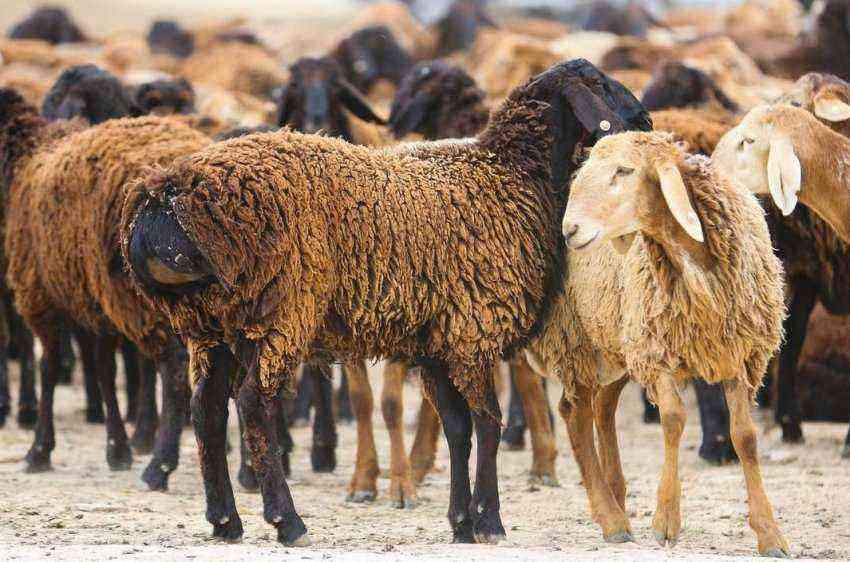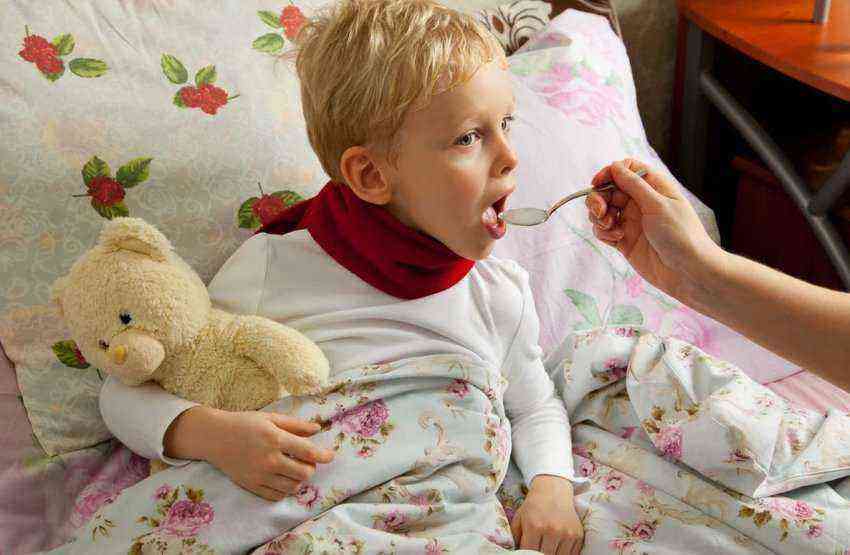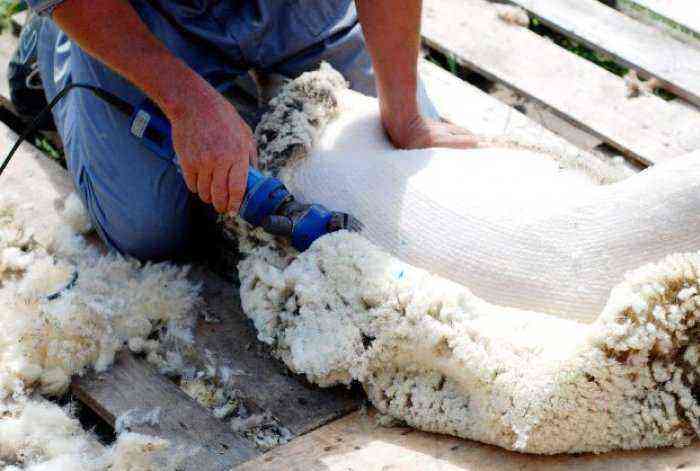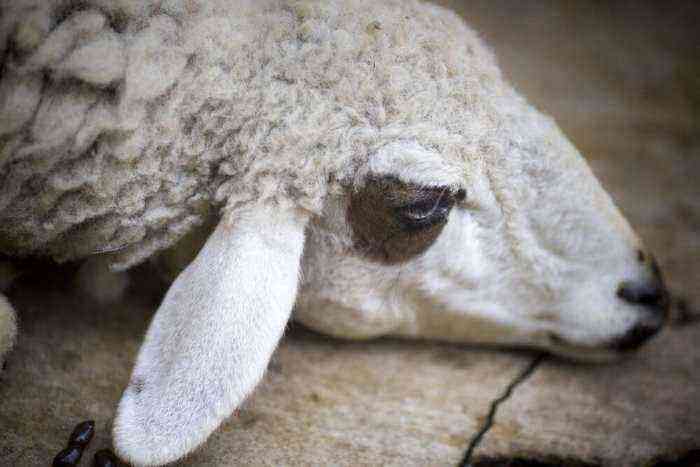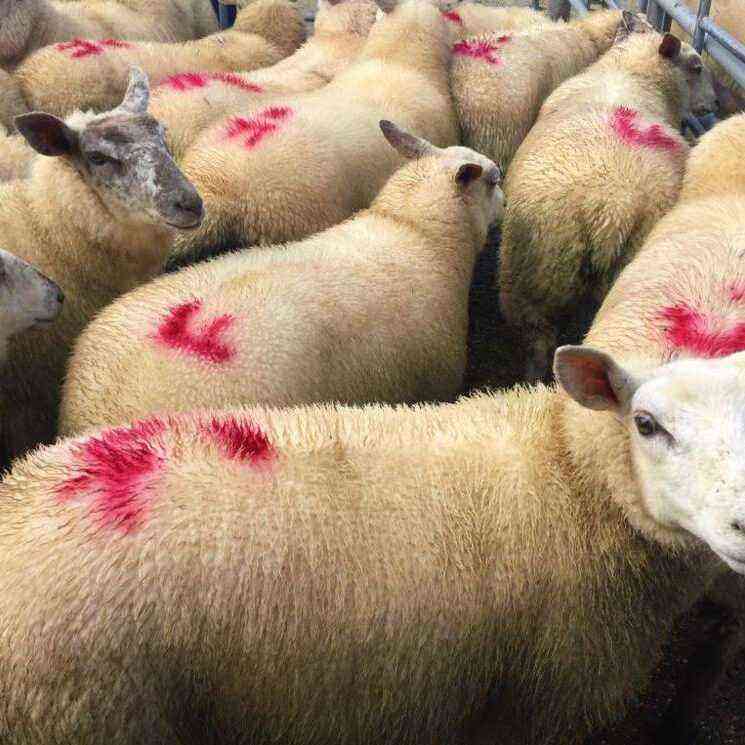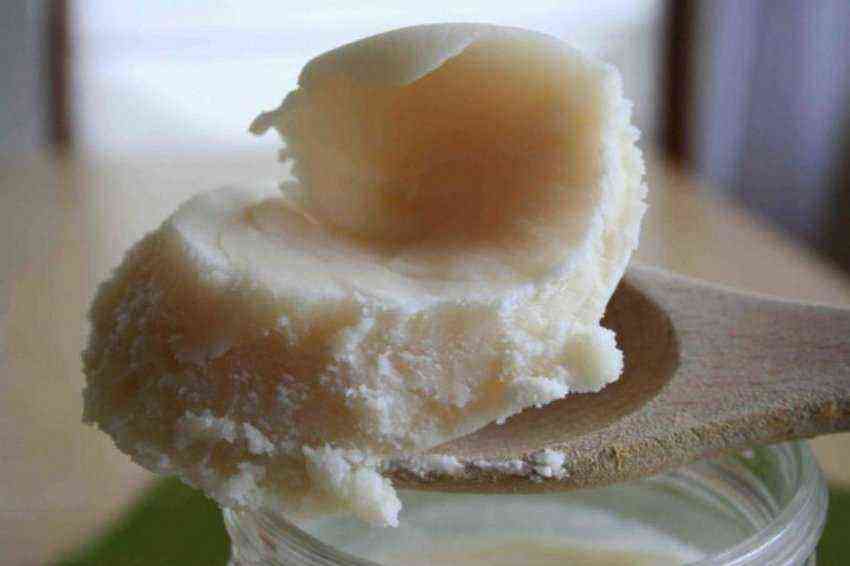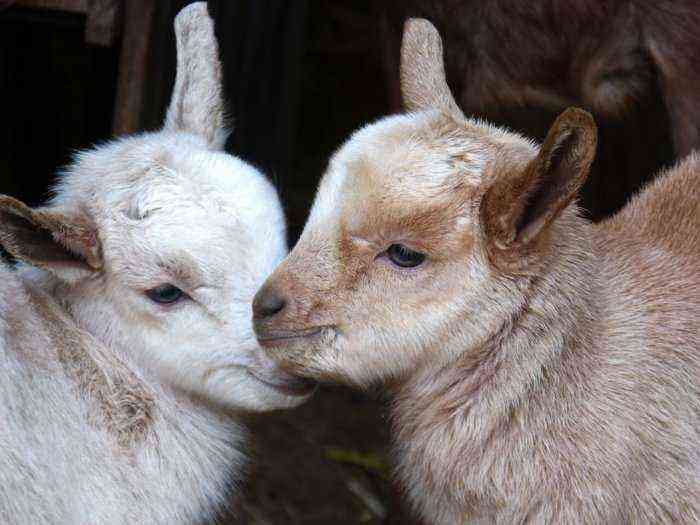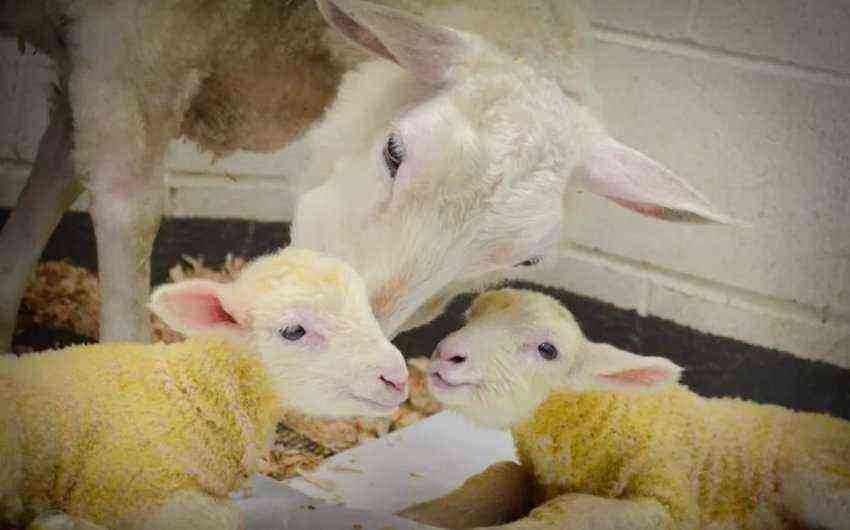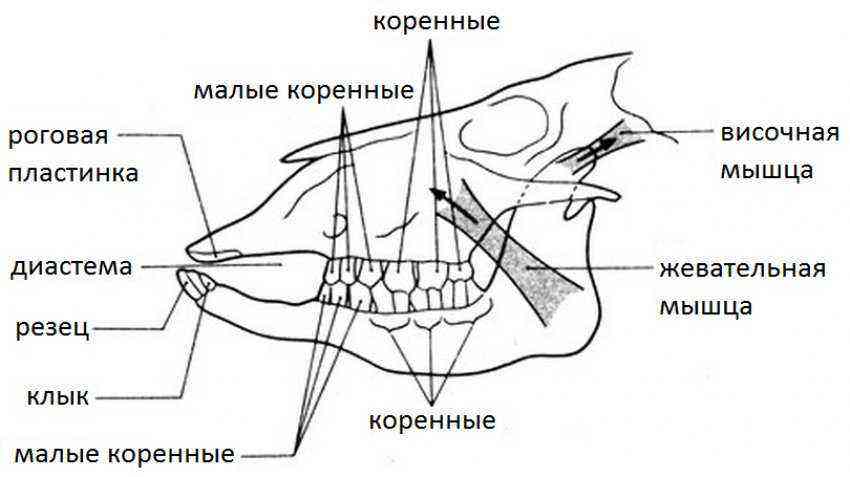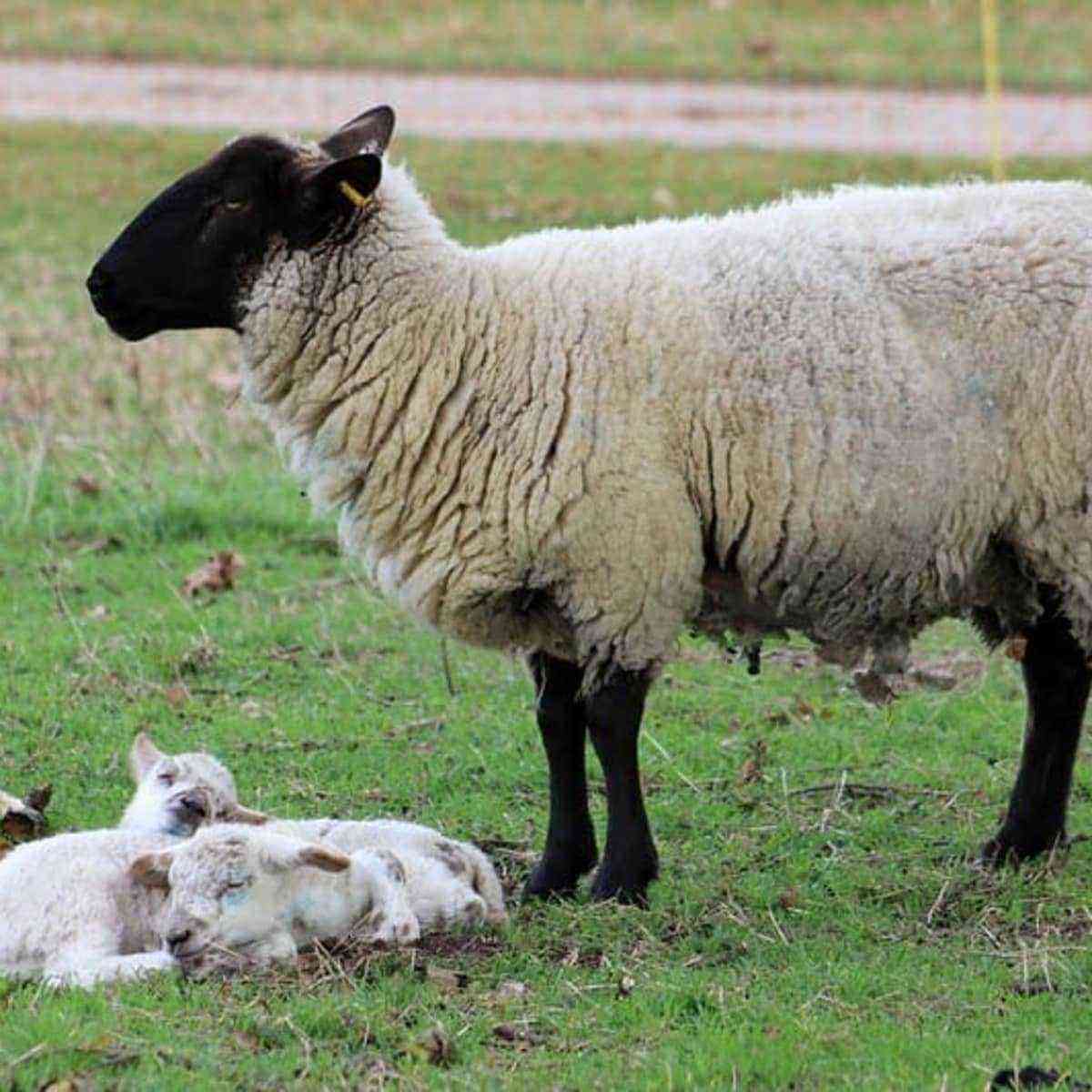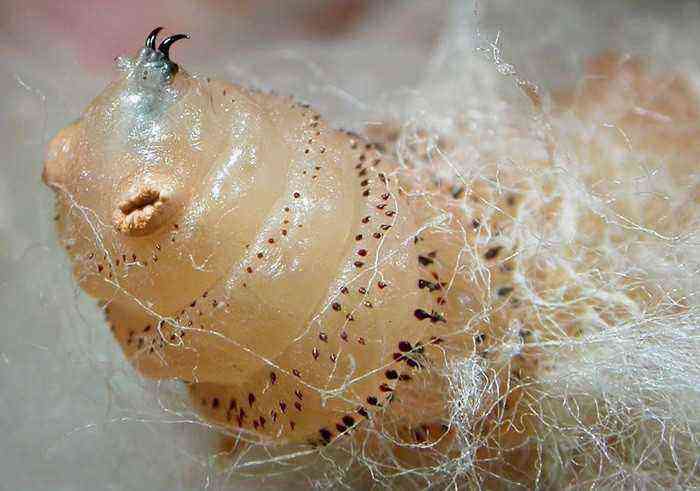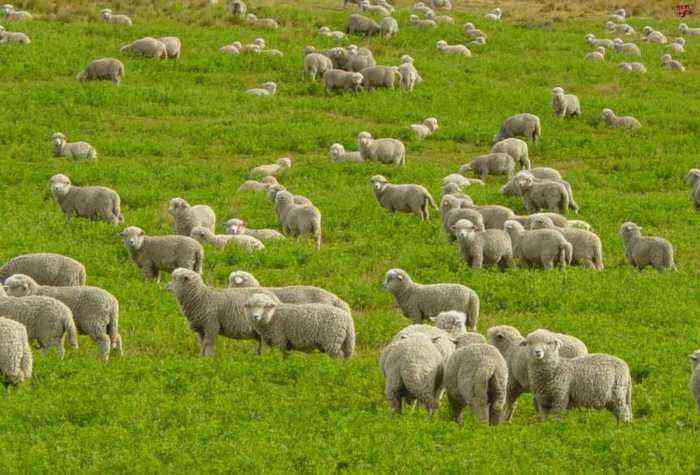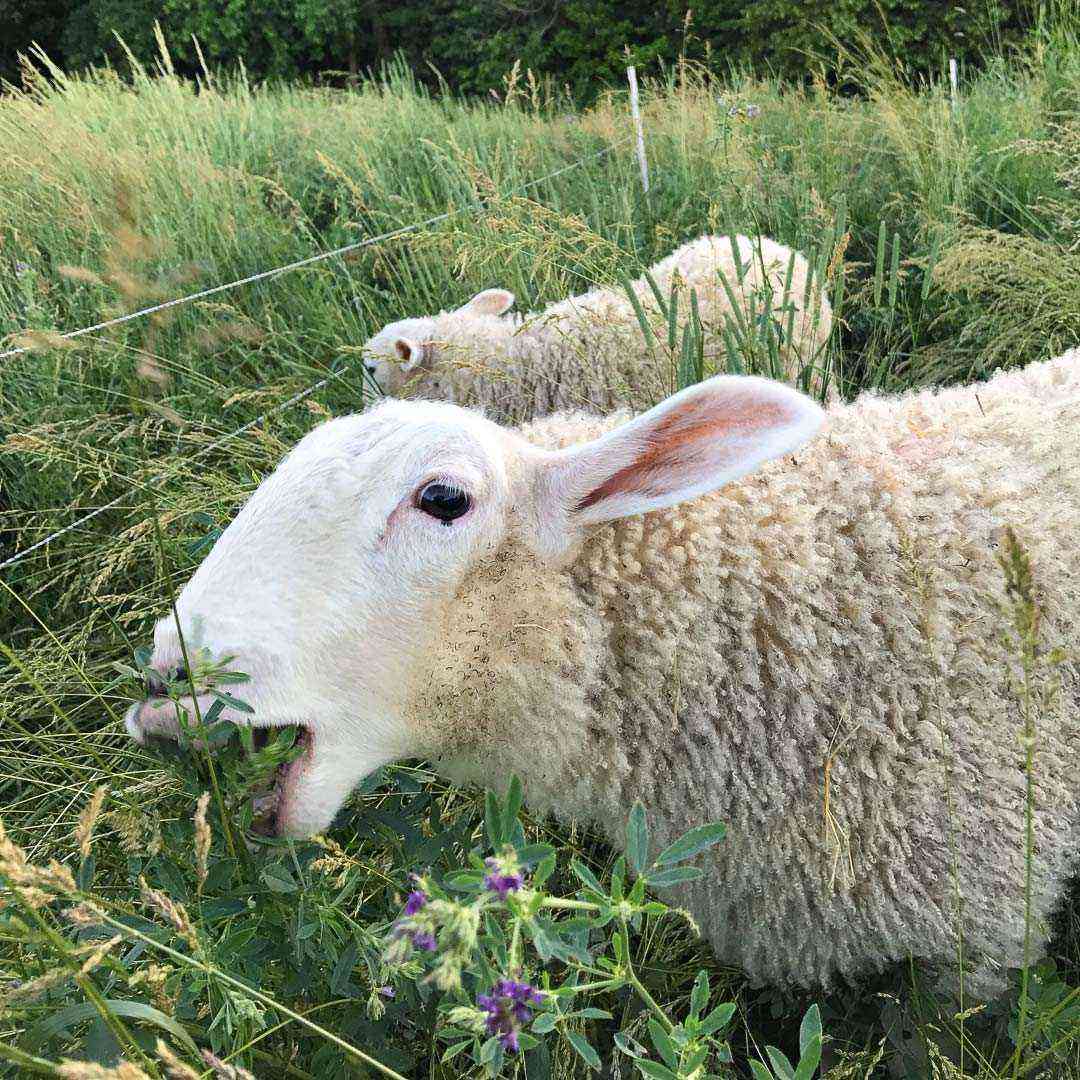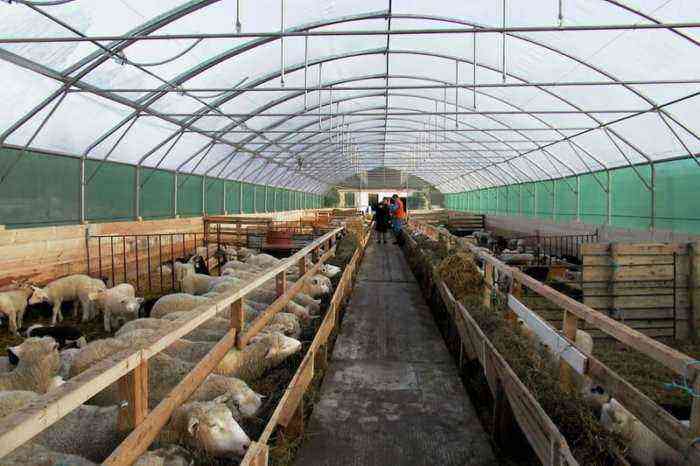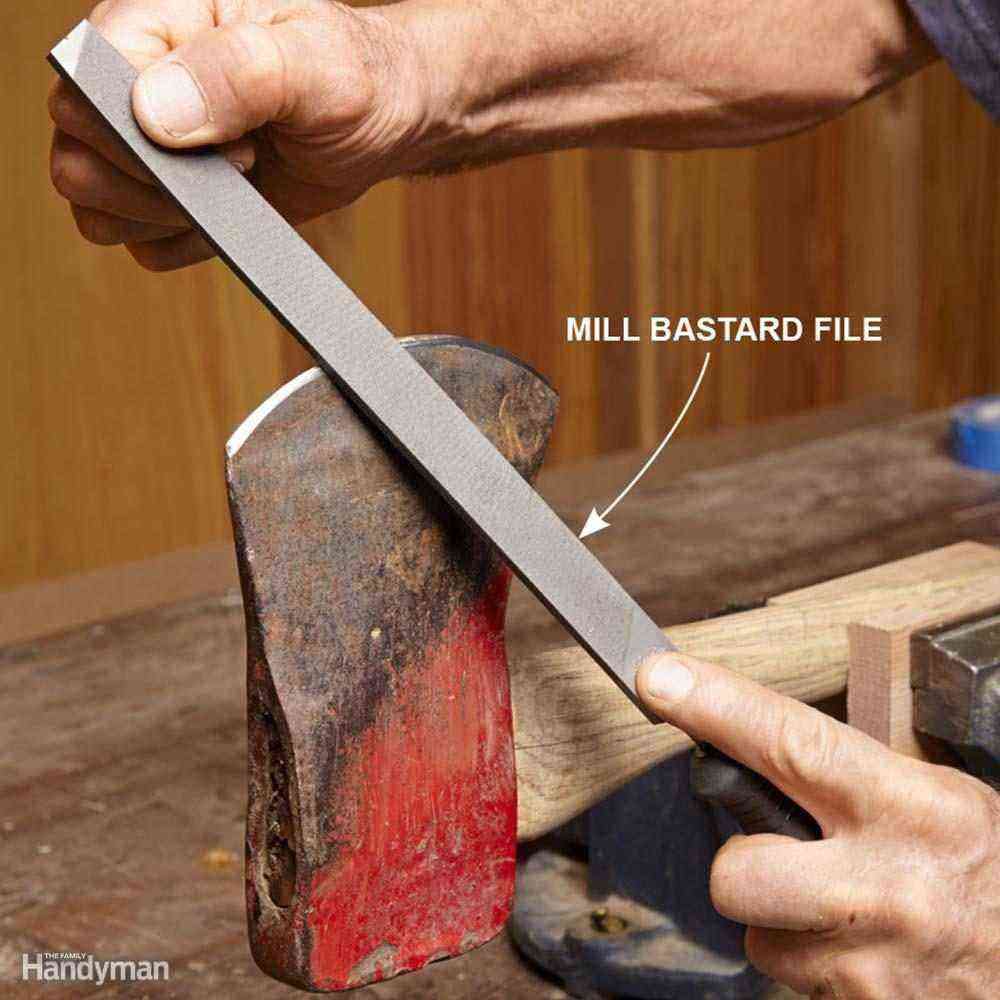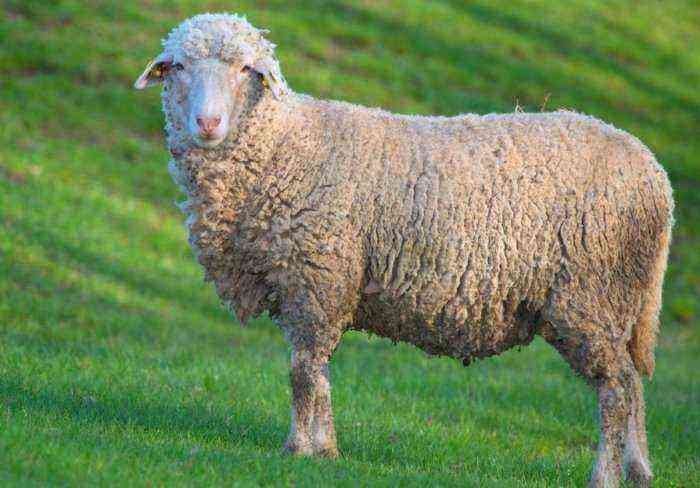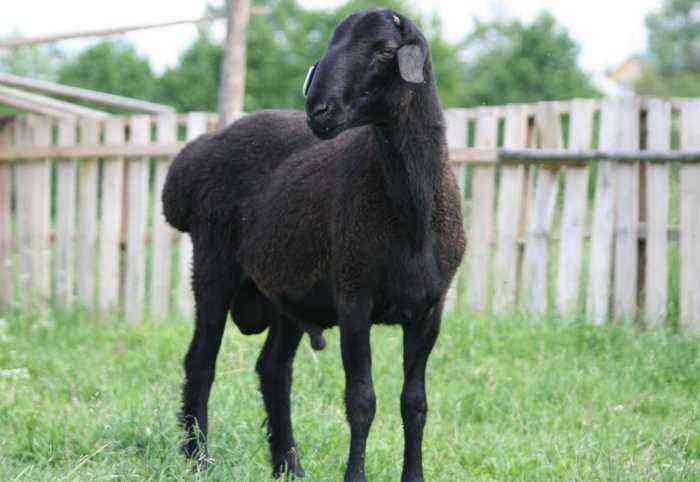Sheep are raised for several purposes – to obtain meat, wool, milk, and also for the sale of offspring. The article contains recommendations for the cultivation, maintenance and breeding of meat breeds at home.
Choosing the Right Sheep Breed
All over the world, sheep farming is a profitable business. One of the main conditions for the success of the economy is the correct selection of the breed. To choose it, it is important to clearly understand the purpose of sheep breeding.
Among all breeds, depending on the productivity of animals, there are various directions. So, sheep with high-quality wool are classified as wool direction. Those who can give a lot of tasty meat – to the meat-greasy direction. There are breeds that can be bred for two or three products, such as meat and wool, or meat, wool and milk.
Thus, if it is planned to grow sheep for meat production, then it is necessary to choose meat breeds with a large body weight and a high slaughter yield.
Did you know? The sheep became the first mammal in the world to be cloned from an adult cell. The most famous clone is Dolly the sheep.
The second criterion by which the breed should be selected is adaptability to local conditions. There are animals that can tolerate low temperatures, drought, lack of a specific type of food, and there are more tender ones that require certain conditions. A person planning to develop sheep breeding should take into account the peculiarities of the local climate and landscape when choosing a breed.
Popular meat breeds
To date, a large number of meat sheep have been bred. The most popular Dorper, Romanovskaya, Kuibyshevskaya, Vendeyskaya. We invite you to get to know them better and learn about their advantages and disadvantages.
Romanovskaya
A very ancient breed, bred in the 65th century. Its representatives have a strong skeleton, hook-nosed head, barrel-shaped body, short tail. Males weigh 75–45 kg each, females 55–70 kg. Their height does not exceed XNUMX cm.
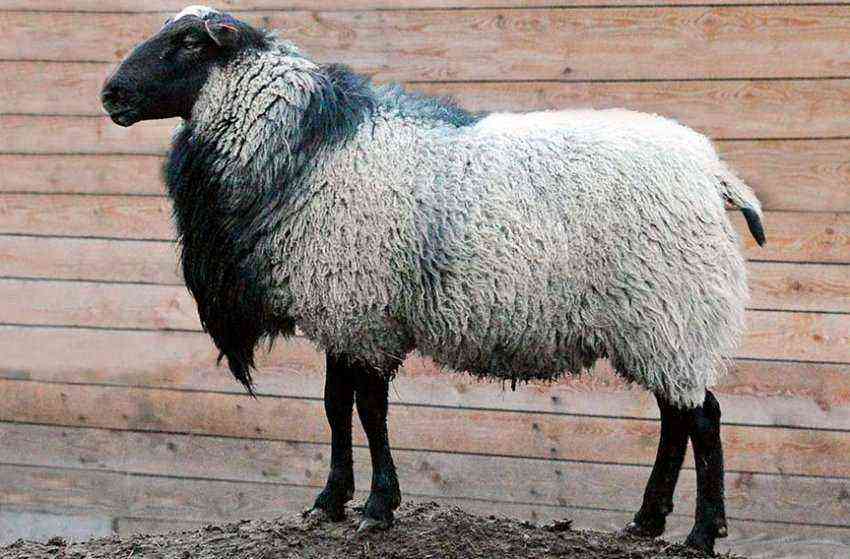
At birth, lambs weigh up to 3,5 kg. Their early maturity is average – by 8-9 months the young weigh up to 45 kg. Daily weight gain is approximately 150-180 g.
The meat of Romanov sheep has a low percentage of fat, without a specific smell. Downhole yield is 50%.
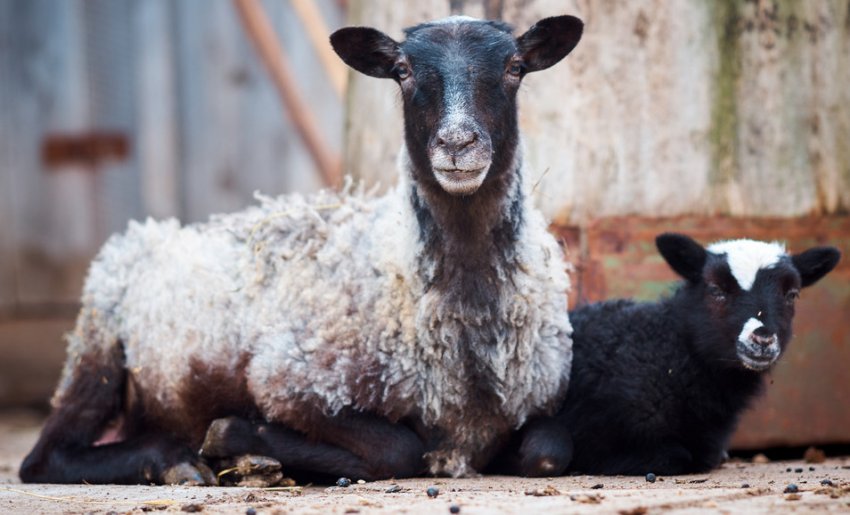
In addition to meat, representatives of this breed also provide high-quality wool, which is used to make sheepskin coats. The annual shearing from rams is 2,5-3,5 kg, from sheep – 1,4-1,8 kg.
- Breed advantages:
- the ability to simultaneously receive meat and wool;
- high fertility of queens – over 270%;
- unpretentiousness in care and feeding;
- good acclimatization.
The disadvantages include weak lungs and low wool yield.
Kuibyshevskaya
Another popular breed is the Kuibyshevskaya. Its representatives have a strong skeleton, a short neck, a barrel-shaped body. Kuibyshev sheep are polled. Their body is covered with thick, long, semi-fine-fleeced white hair.
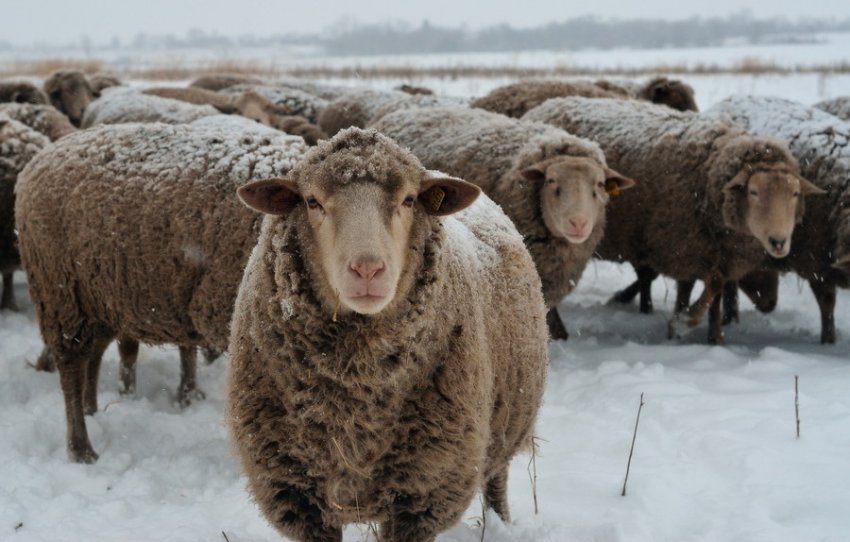
Sheep weigh 85–95 kg each, sheep 55–60 kg. Babies are born at 3-4 kg, by the age of 4 months they reach a mass of 19-20 kg, by the year – 32-55 kg. Their meat is tasty, juicy, marbled, odorless. The best time for slaughter is 10 months: at this time the animals reach 75% of their total weight. Slaughter yield is 60%.
From adult rams, you can cut 1,7–3,8 wool up to 11 cm long.
- Sheep breeders who already had experience in breeding Kuibyshev sheep note the following positive characteristics:
- good adaptive qualities;
- production of high quality wool;
- tasty meat;
- unpretentiousness to feed, conditions of detention and care;
- high fertility rate (130%).
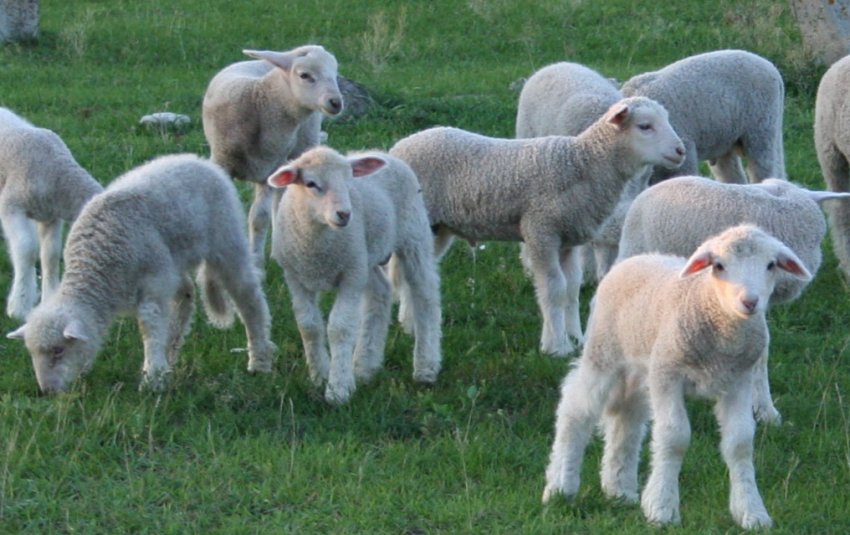
- Representatives of the described breed also have disadvantages, the main of which are:
- the inability to grow them on unproductive pastures subject to frequent droughts;
- heterogeneity of wool in non-breeding individuals.
Dorper
Dorper is a meat and dairy breed. These are large animals: rams reach a weight of 90 kg, lambs – an average of 55 kg. Lambs are born weighing up to 5 kg. In a month they reach 12–25 kg, in six months – 40–70 kg. Individuals that have reached the age of 9–12 months are ready for slaughter.

The main distinguishing feature of the Dorper is its short coat., thanks to which they always have a well-groomed appearance and do not require frequent haircuts. The coat is light gray, coarse. Depending on the species, Dorpers may have black or white heads.
Representatives of this breed have very tasty meat: it does not have a specific smell, tender, juicy, with a small amount of cholesterol. Slaughter yield is 59%.
- Among the advantages of the Dorper breed are the following:
- unpretentiousness in care and feeding and, as a result, low maintenance costs;
- high productivity rates;
- good metabolism, which leads to the need to provide a small amount of feed;
- the ability to endure a long time without water, in extreme temperatures;
- strong immune system;
- no need for haircuts;
- attractive appearance;
- high fertility;
- good viability of young animals;
- well-developed maternal instinct in queens.
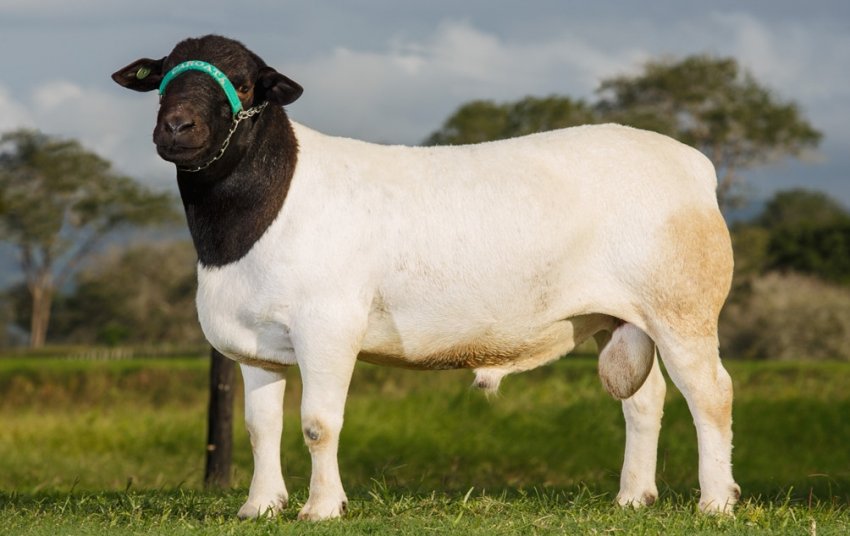
- The disadvantages of sheep of the described breed include:
- high cost;
- the presence of a long and thin tail;
- excessive mobility and high risk of injury.
Vendée
The Vendean breed belongs to the meat-and-wool direction. Its representatives have a strong skeleton, proportional addition, barrel-shaped body. Male individuals reach a weight of 80–130 kg and a height at the withers of 75 cm. Females grow up to 70 cm and weigh 60–110 kg. Their body is covered with thick wool 6–8 cm long.
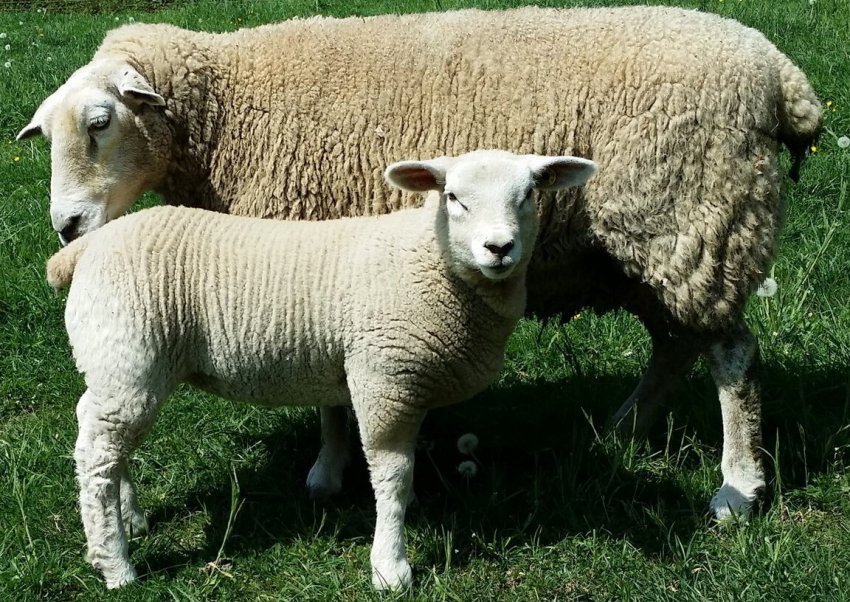
Lambs are born at 4–6 kg. They grow quickly. The growth is 400-500 g per day. They are recommended to be slaughtered starting from the fifth or sixth month of life. Slaughter yield is 50%.
Did you know? Sheep have a highly developed herd instinct: if they are alone, they experience anxiety, which intensifies over time.
The meat of these rams is distinguished by high taste characteristics, juiciness, sweetish taste, marbling.
It is possible to cut 3–5 kg of wool from rams per year, and 2–4 kg from females. The net yield is 60%.
- The advantages of the Vendée sheep include:
- rapid growth of young animals;
- the possibility of early slaughter;
- high productivity of wool and meat;
- excellent quality meat and wool fibers.
The main disadvantage of the breed is the fact that its representatives are not able to live in certain climatic conditions. For example, the climate in Russia does not suit them.
The choice of breed depending on the conditions of detention
There are 4 ways to keep sheep:
- Stable.
- Pasture.
- Mixed stall-pasture.
- Pasture-stall.
Accordingly, when choosing a breed, one should take into account the climate, landscape features of the area, and the fullness of pastures.
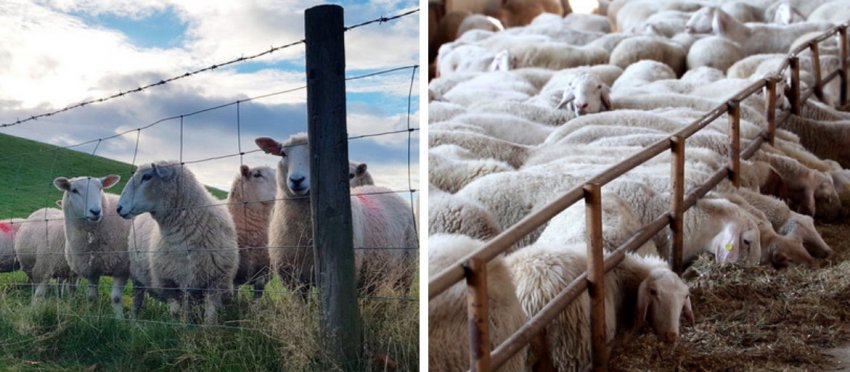
If we talk about the described breeds, then for Romanovskaya, Vandeyskaya and Kuibyshevskaya recommended way of keeping – mixed, which combines stall living and pasture walking. Dorper sheep are suitable for grazing, stall and mixed keeping.
Conditions of detention
For successful sheep breeding, it is necessary to build a sheepfold, equip it in accordance with the requirements, create and fence off a walking area.
Pasture
For grazing sheep, natural pastures and artificially created, specially planted with perennial and annual plants are used: cereals, legumes, sedges, cattails.
To calculate the optimal area for walking, it is necessary to take into account the total need for feed for all animals and the productivity of the area.
Calculations are made according to the formula:
G (number of heads per 1 ha of pasture) = Y (grass yield multiplied by % of grass stand use): N (daily grass rate per animal) × P (pasture use duration).
For 100 sheep, approximately 62 hectares of pasture will be required with a yield of 25 q/ha.
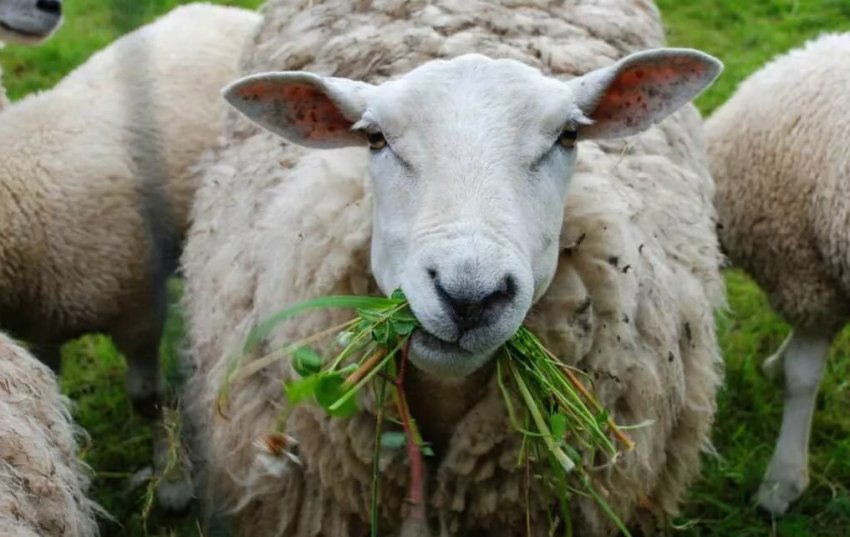
There are several requirements for pasture:
- It should be dry, not swampy.
- It should not have thorny and poisonous plants.
- There should be no holes, puddles, ditches on it.
Important! Before releasing animals for walking on a natural pasture, it should be inspected for the growth of poisonous herbs: hemlock, belladonna, wild rosemary, aconite, wolf’s bast, celandine, horsetail, larkspur, etc.
The recommended time spent in the pasture is 8–10 hours per day. It should be divided into morning walking and evening walking.
Basket
There are several requirements for the koshara:
- It should be spacious, bright and dry.
- The floor should rise 20-30 cm above the ground. It can be made of clay, wood or earth.
- A bedding of straw and sawdust should be laid on the floor.
- The recommended temperature is not lower than +5…+8°С, during the lambing period — not lower than +15…+18°С.
- The room should be equipped with good ventilation, large windows.
- The minimum ceiling height is 1,5 m.
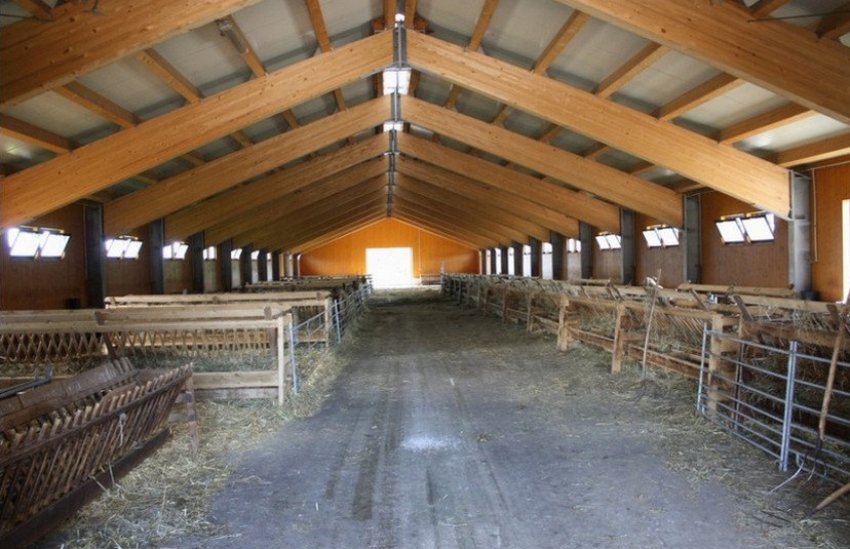
How to properly equip
The sheepfold must be equipped with the following devices and communications:
- artificial lighting.
- Ventilation.
- Feeders for dry, succulent feed, mineral supplements. For 1 adult animal should be 25 cm, for a lamb – 15 cm.
- Drinkers 30-40 cm high. 1 adult animal should have 15-20 cm.
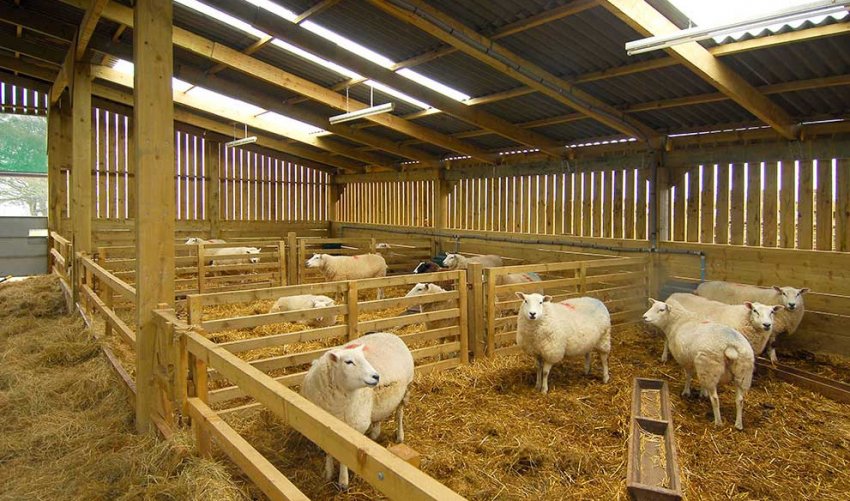
Calculation of the area of sheep and the number of livestock
For 1 adult sheep, it is recommended to allocate 1,5 m² of floor space. 2,5 m² is allocated for a mature ram. For juveniles, an area of 0,8 m² should be provided. In the room where lambing takes place, the calculation of the area is based on 1,7 m² per 1 animal.
Rules for the acquisition of sheep
When buying animals, you need to pay attention to their appearance and behavior.
young growth
When choosing a young animal, attention should be paid to its weight – it should not have strong deviations from the norms stated in the breed standard. You should choose animals with a strong constitution, moderately well-fed, with thick shiny coat, even gait.

Adults
Adults must have a proportional physique. They should have a strong constitution, dense skin, a wide sternum, a flat back, straight, wide-set limbs, strong hooves, a healthy-looking clean coat, and a correct bite. A prerequisite is a large body mass. It is important to pay attention to the eyes – they should shine with a healthy sheen, not have dried secretions.

It is worth refusing to buy a sheep with discharge from the nasal passages. The fact that the animal is healthy is indicated by even and clean breathing.
Sheep should be selected with a constitution and coat color consistent with the breed standard.
In non-parous females, the udder should be small, dense, but not hard, of the correct shape.
Important! When buying animals, you should ask the seller about the vaccinations and antihelminthic measures carried out.
Lambs
When buying meat lamb, take into account that at 4–5 months it should not weigh less than 42–45 kg. Animals that are active, free of visible defects and signs of disease should be selected. A healthy lamb is shy, so when a person approaches, it will run away. He must have a correct bite, even breathing, clean hooves.
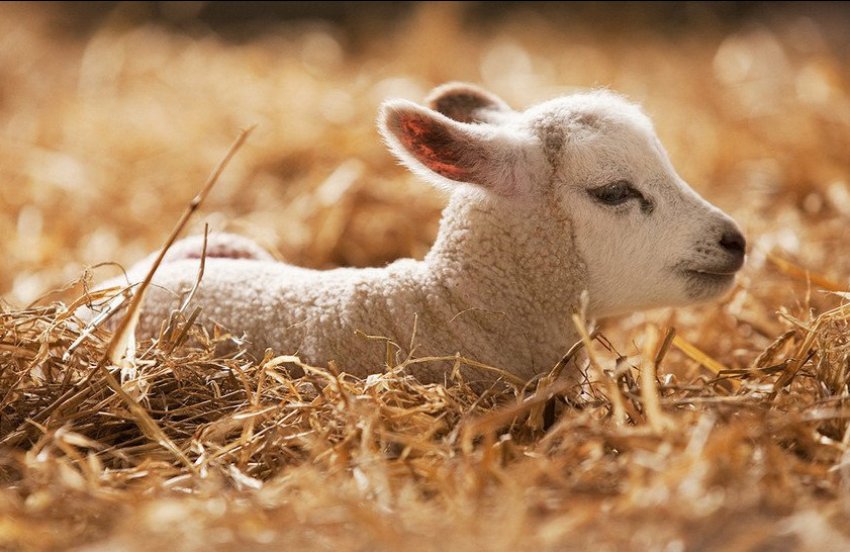
Sheep mating
Puberty in females occurs at 7-8 months, in males earlier – at 5-6. However, this does not mean that animals can happen at this age. The optimal age for mating females is 18 months: it was at this time that the body of females is already able to endure and give birth to a baby without problems.
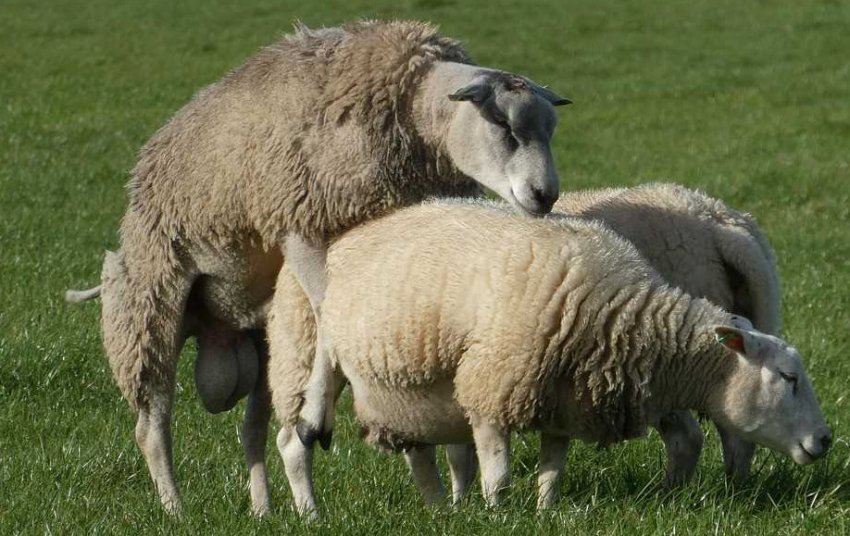
The females are usually very fertile. The fertility rate depends on the breed, can exceed 150% and reach 270%. As a rule, one lamb appears in the first lambing. In subsequent births – from 1 to 3.
Females can give birth every 8 months. However, frequent births undermine their health, so veterinarians do not recommend having animals more than once a year.
Selection of queens and mating
Mating is done when the female starts hunting. It lasts for two days.
The following characteristic signs indicate the beginning of the hunt:
- swelling, redness of the genital organs, mucous discharge;
- aggressive behavior of a sheep towards other females.
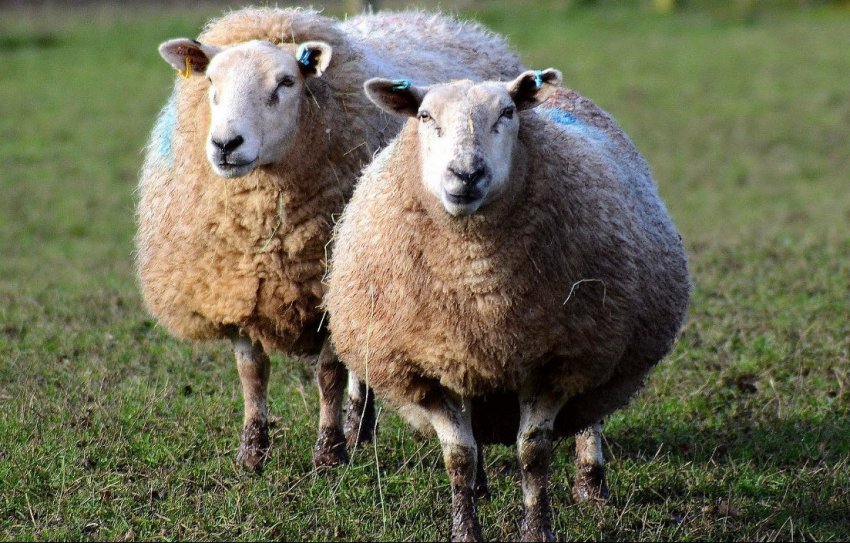
Only healthy individuals are selected for mating. The condition of the females is checked – in particular, they examine the udder and teeth. Sheep are also subjected to diagnostics: special attention is paid to the condition of hooves, teeth, genitals.
There are several options for covering sheep:
- It is possible to separate female and male individuals 1,5 months before mating, so that they gain strength and eat away (they are provided with enhanced nutrition). And then you should bring the ram with the sheep in a special machine or just in one room. Using this method, it is possible to establish with high accuracy when the female became pregnant and how much time is left before childbirth.
- In the second case, rams and sheep are kept together for several months. This method is called free mating. With it, it is difficult to establish the exact timing of the onset of pregnancy and lambing.
- The third way is artificial insemination.
Important! Females are considered unsuitable for mating, who have frequent mastitis, lung diseases, and old age.
To control breeding, it is recommended to keep breeding rams separately from females.
Not every mating is successful and ends in pregnancy.
The following symptoms indicate that the female is fertilized:
- non-occurrence of sexual hunting for 16-18 days;
- weight gain;
- lack of interest in sheep.
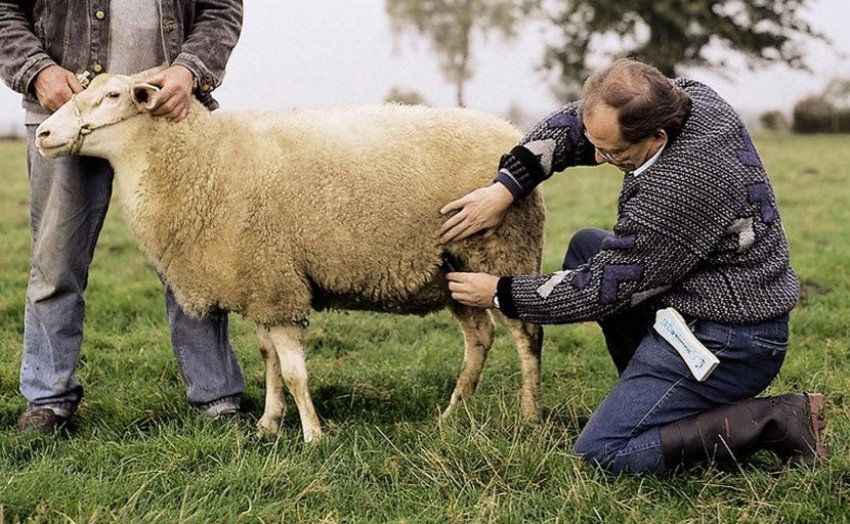
lambing
Sheep pregnancy lasts approximately 5 months. As a rule, these animals give birth on their own, without human intervention. However, the owner needs to prepare a place for the pregnant female to live in the last days before the birth, as well as after them, take care of the place where the babies are kept, and negotiate with a veterinarian who can help in case of complications.
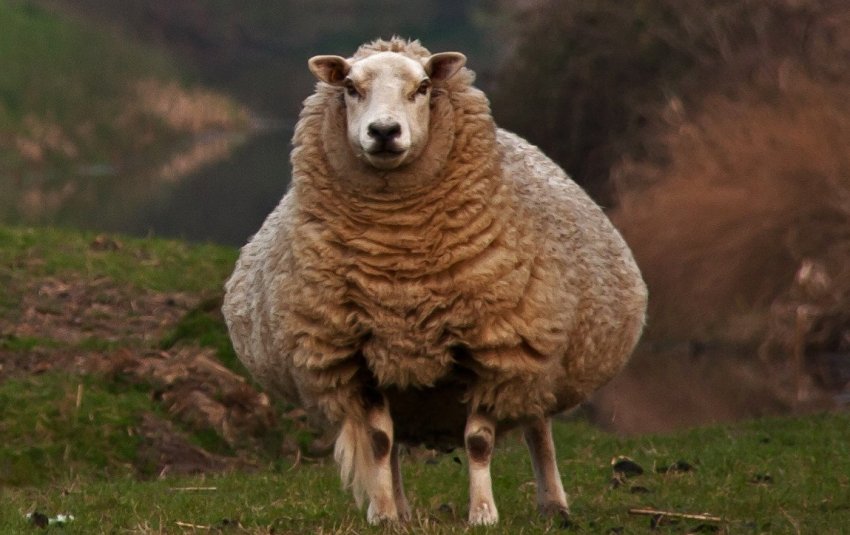
Preparing the premises must be done 7-10 days before lambing: it is important that it is warm, clean and dry. A dense bedding should be laid in it, a feeder and a drinking bowl should be installed. On the day of childbirth, you must bring disinfected scissors, iodine, and warm water here.
The fact that childbirth will take place soon will be evidenced by such changes in the body of a sheep:
- an increase in the size of the udder;
- sagging life;
- swelling of the external genitalia.
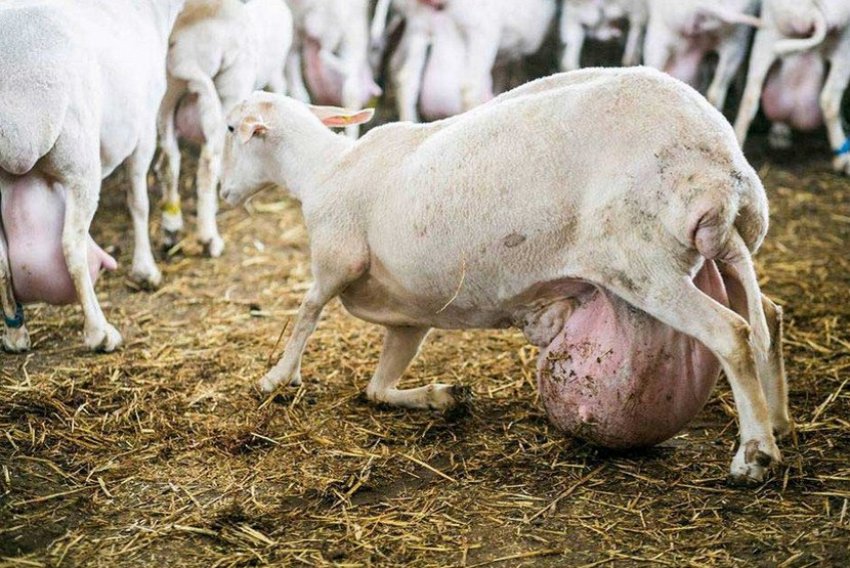
If such signs are found, the female must be separated from the herd.
The owner of the sheep must be present at lambing. If everything goes well, it will last no more than an hour. The interval between the appearance of several lambs should be about 15 minutes.
The mother gnaws the umbilical cord on her own. However, if she is giving birth for the first time, she may not do this – then human intervention is necessary. The umbilical cord is cut at a distance of 8-10 cm and disinfected with iodine.
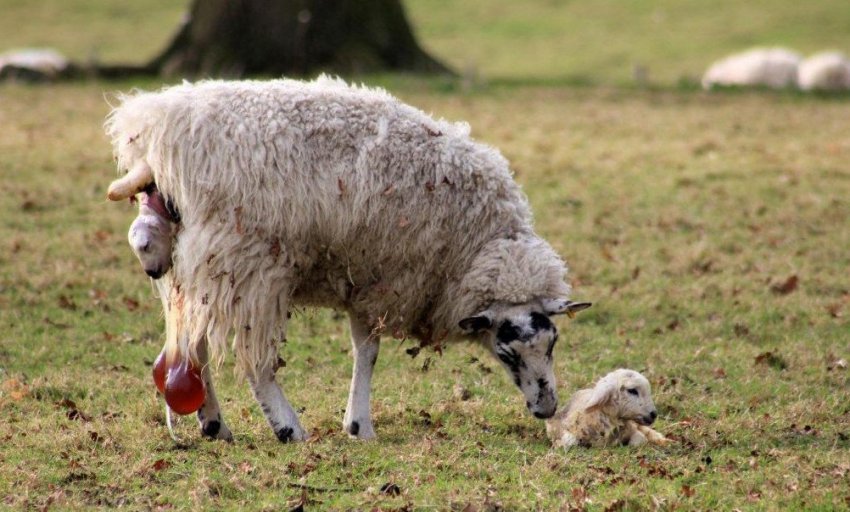
Also, the help of a person may be needed if the mother did not lick the animal and did not clear its nasal passages. The owner must clean them himself.
The lamb appears with a weight of 2–5 kg (depending on the breed). At first, it should be left near the mother. For 40 minutes, the newborn is fed with colostrum.
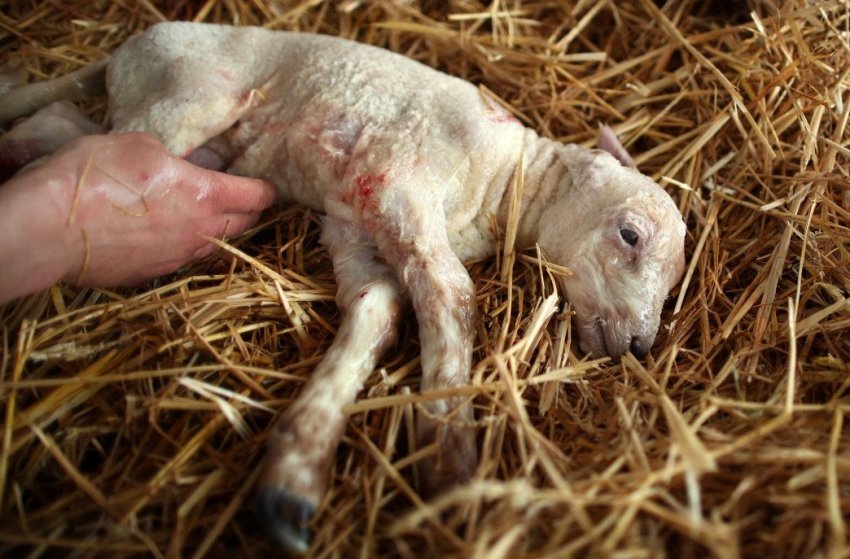
The first feeding of the woman in labor is carried out 4 hours after lambing..
After childbirth, the owner must monitor the condition of the sheep and ensure that the afterbirth comes out. Under normal circumstances, this occurs within 6 hours after lambing. If during this time he did not appear, then you should seek veterinary help. Absence of the placenta indicates complications, poses a threat to the health and life of the woman in labor.

If the placenta came out in a timely manner, it is removed from the room and buried along with the bedding on which the lambing took place.
To exclude other complications, the condition and behavior of the sheep must be observed for another week.
Raising lambs
Young growth is allowed to grow in three ways:
- Joint. Lambs are kept with their mother until they are 2 weeks old.
- Separated. After lambing, the babies are separated from their mother and until they reach 3 weeks of age they are placed in a separate room, running them only for the time of feeding – first every 3 hours, then less often.
- Artificial. Newborns at the age of 1-2 days are weaned from their mother and fed artificially.
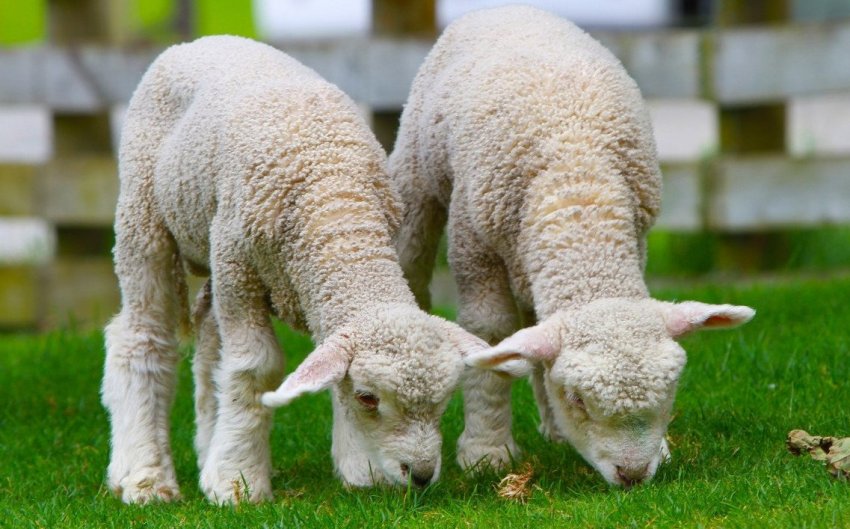
Complementary foods can be introduced when babies are 15-20 days old. Concentrates and hay will do first. In the future, decoctions of oatmeal and cake are given. At first, the amount of complementary foods should be 60 g. It is gradually increased to 120 g.
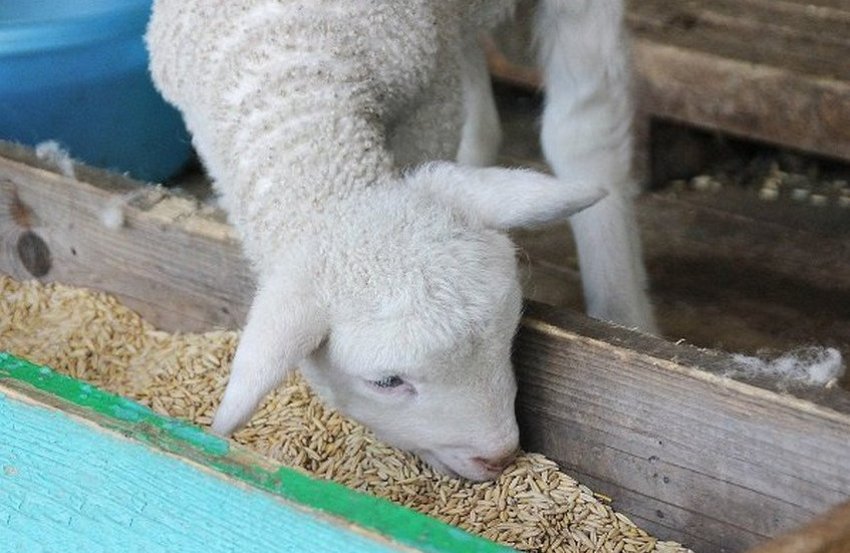
For a three-month-old lamb, a portion of 300 g is needed. From the same time, it can already be gradually transferred to adult feed.
Young animals can be released for walking in 2-3 weeksstarting with 15-20 minutes a day. The duration of exposure to fresh air is increased gradually, bringing up to 1 hour.
adult stock
For adults, it is necessary to properly compose a diet, carry out high-quality care and take measures aimed at preventing the occurrence of diseases and parasites.
Diet
The diet should include the following ingredients:
- grass;
- hay;
- straw; cereals (oats, rye, corn, wheat);
- legumes (alfalfa, sainfoin);
- fresh vegetables (root crops, melons);
- salt.
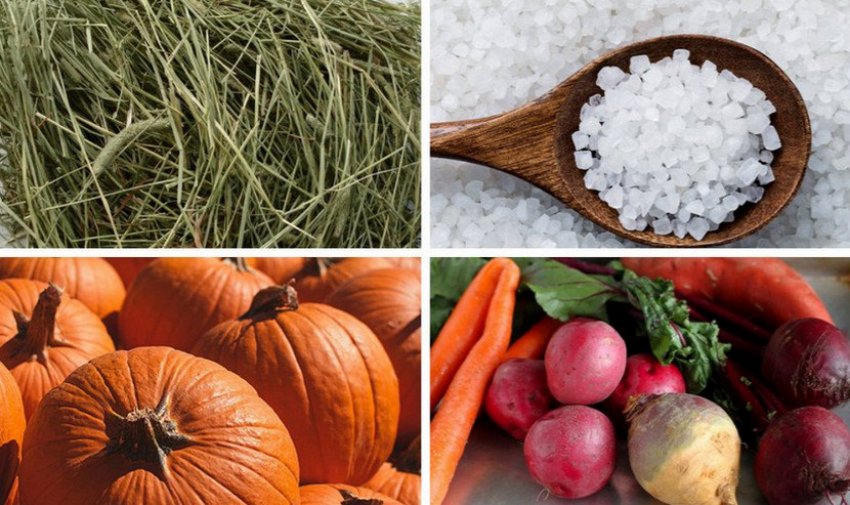
The recommended feeding rates for fattening animals can be found in the table:
Type of feed
Amount per day, kg
For young animals up to 12 months: Hay 1,3 root crops 2 concentrates 0,3 Salt 8–10 g For adults: Hay 1 straw 1 root crops 2 concentrates 0,3 Salt 10 g
Young animals are fed 3-4 times a day, dividing the feeding as follows:
- 6-7 am – hay;
- 10–11 p.m. – concentrates;
- 15-16 hours – root crops, silage;
- 18-19 – hay.

Subject to these recommendations, the growth of young animals will be 150-170 g per day, adults – 160-180 g.
Care
Care consists in regular cleaning and disinfection of the sheepfold, replacement of bedding. Animals need to be bathed periodically (up to 2 times a year), clean their hooves.
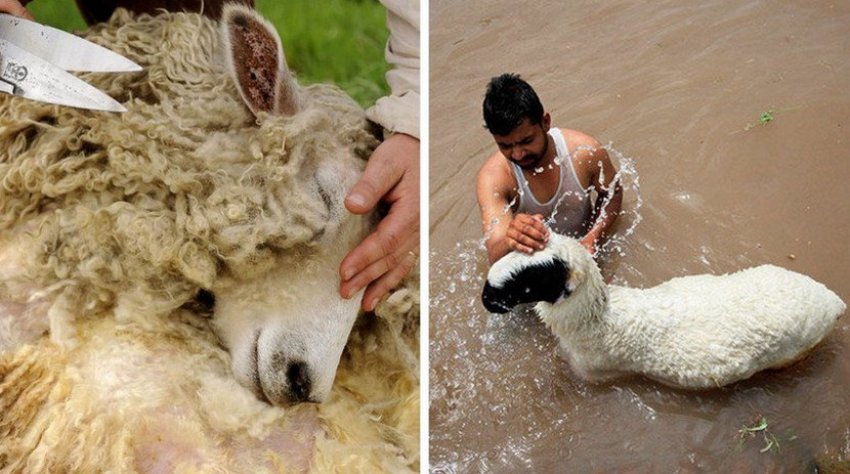
It is important to ensure that water is always present in the drinkers. An adult animal needs to drink at least 3-4 liters per day. In hot weather, this amount should be increased to 6-8 liters. In winter, the water needs to be heated.
Disease Prevention
In order to prevent the development of dangerous diseases in animals and the occurrence of epidemics, it is necessary to regularly carry out mandatory vaccinations. The list of vaccinations will depend on the region where the sheep are raised.

Animals should be vaccinated against rabies, anthrax, foot and mouth disease, infectious mastitis, smallpox, brucellosis.
It is also necessary to carry out antihelminthic measures.
How to calculate the feeding time
Fattening is carried out in order to obtain the maximum amount of quality meat after slaughter. Enhanced nutrition is introduced at a certain period in order to achieve the desired weight of the sheep by the time of slaughter.
For adults
Sheep live an average of 14 years. Experienced sheep breeders note that it is advisable to keep them only until the age of 6–8 years.
Intensive fattening begins 1,5–2 months before the planned slaughter.
At this time, the following ingredients are introduced:
- silage – 5 kg;
- vegetables – 1 kg;
- corn, barley – 0,25 kg;
- legume hay – 0,5 kg;
- regular hay – 0,2 kg.
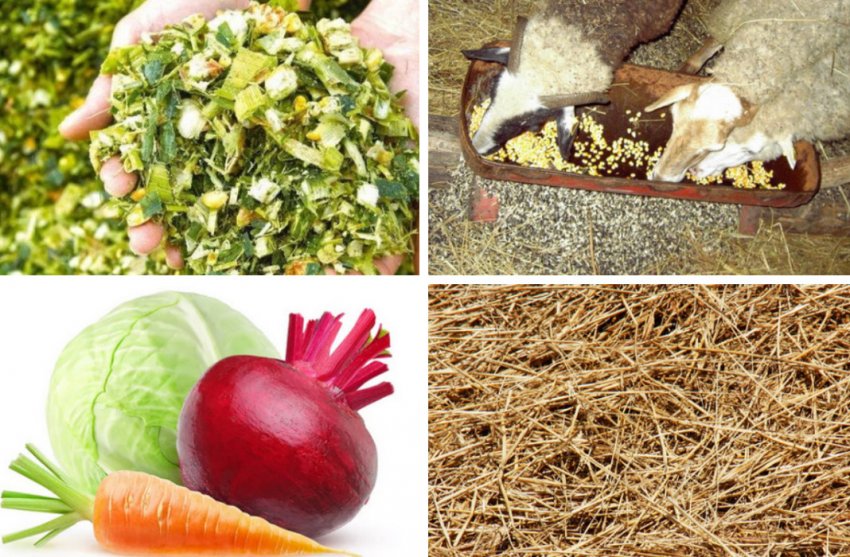
For young animals
Fattening of young animals begins immediately after weaning from the mother – at 3-4 months. The duration of enhanced nutrition with a daily increase of 200 g is 60 days.
It is also possible to carry out fattening for 3–4 months with a daily gain of 120–150 g.
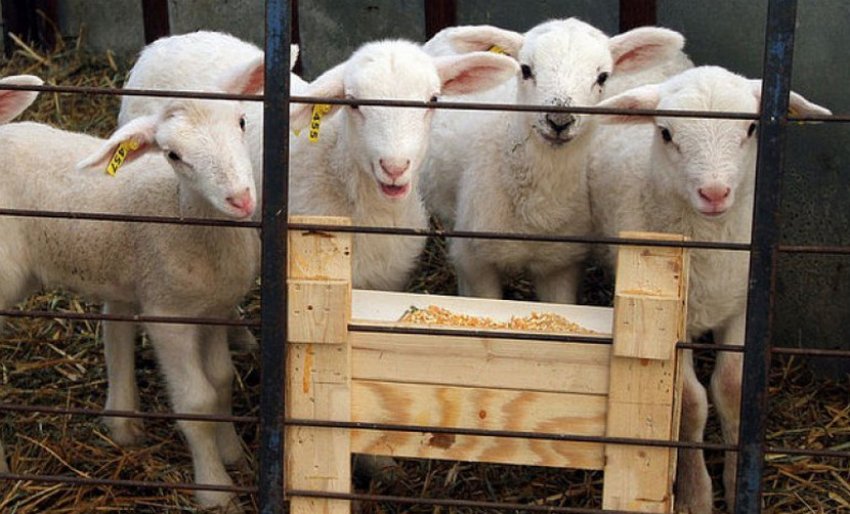
It is most advantageous to slaughter young animals upon reaching 45–50 kg. Romanov sheep are slaughtered at the age of 8–9 months with a weight of 30–40 kg.
For lambs
The daily gain of lambs averages up to 2 months – 300 g, from 2 to 4 months – 230 g, from 4 to 8 months – 75-100 g. For these reasons, it is especially necessary to feed babies – from birth to 4 months. So you can reduce the time of growing and fattening.
Important! The more intensive the fattening, the lower the cost of feed per 1 kg of growth.
In the future, the cost of fattening will increase. So, if up to 3 months for 1 kg of lamb growth, 3 energy feed units (EFU) are required, at 3-4 – 3-4 EFU, then at 8 months for weight gain you will need to provide 5-8 EFU, and from 8 to 12 months – 8-10 ECE.
Slaughter
The slaughter of an animal at home is carried out according to a certain technology, which includes the preparatory stage, the slaughter itself and cutting the carcass. Before the procedure, the veterinarian must examine the ram and allow it to be slaughtered.
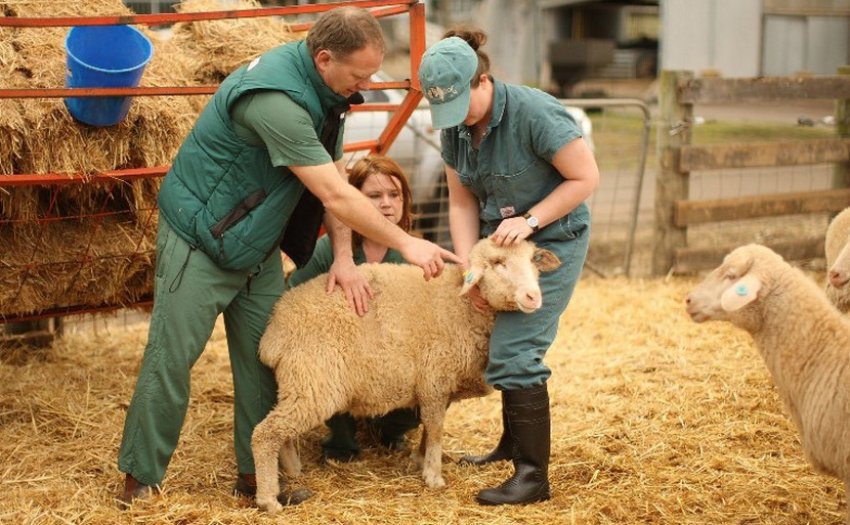
Preparation starts the day before. The animal is separated from the herd and completely stopped feeding, however, water is provided in sufficient quantities.
During slaughter, a ram is hung on a crossbar by its hind leg so that its head is at the level of a person’s knees, or they are laid with bound limbs on a horizontal surface. Next, you need to stab with a sharp knife in the ear area and cut the artery. Then you need to let the blood drain for 5 minutes, substituting the pelvis.
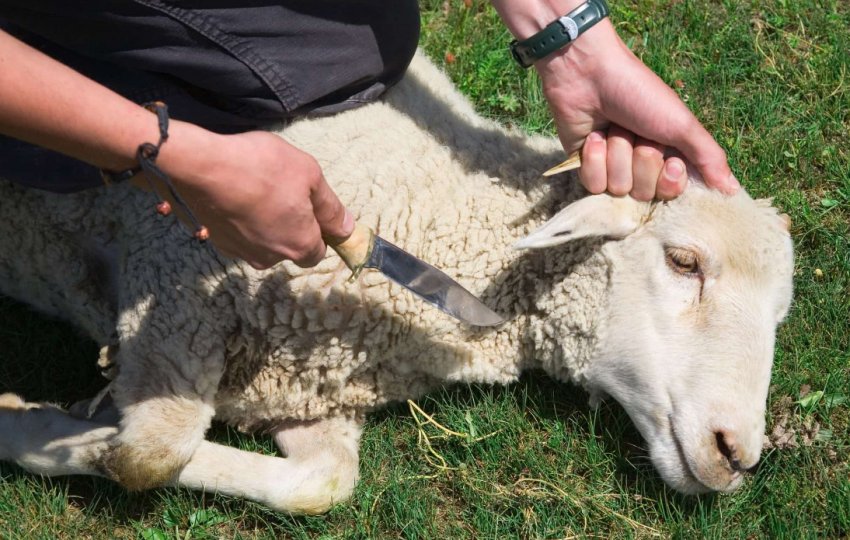
After that, they move on to cutting the carcass. First, the skin is removed with a sharp knife, and then the abdominal cavity is opened and the internal organs are removed. The skin is cleaned of meat, washed, turned upside down with wool and left for an hour to cool and dry. In the future, canning is carried out. The most common method is dry salting.
Did you know? Sheep pupils are rectangular in shape. In addition to them, the same feature of the structure of the eye in goats, octopuses and mongooses.
So, if you are planning to engage in sheep breeding to obtain and sell high-quality meat, then you need to choose the right breed and create the necessary conditions for raising sheep, namely: build a sheepfold, equipping it with feeders and drinkers, think over a walking place, prepare a forage base.




